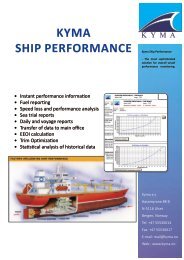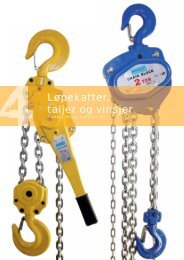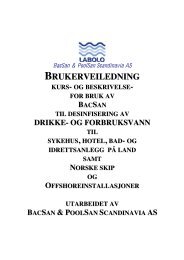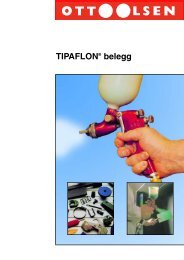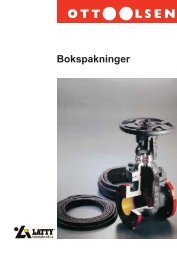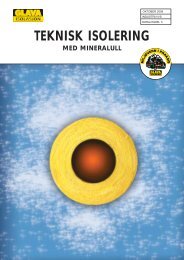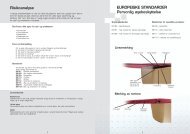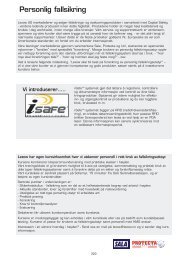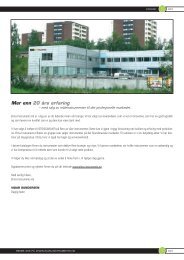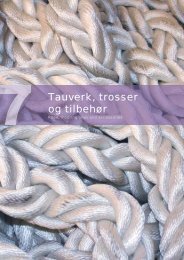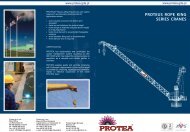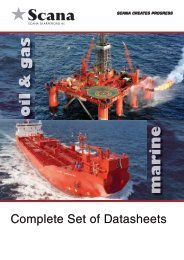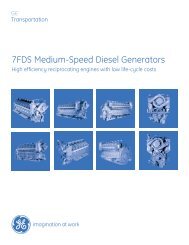7590 Hempadur Fibre 4760 brochure_REN2.indd - Net
7590 Hempadur Fibre 4760 brochure_REN2.indd - Net
7590 Hempadur Fibre 4760 brochure_REN2.indd - Net
You also want an ePaper? Increase the reach of your titles
YUMPU automatically turns print PDFs into web optimized ePapers that Google loves.
HEMPADUR FIBRE <strong>4760</strong><br />
Flexibility where it counts
2<br />
Ballast tank challenge • Technology • Performance<br />
Universal primer concept • Cost-effective where it counts<br />
Contents
<strong>Fibre</strong>-based advantage<br />
for ballast tanks<br />
The new dimension in<br />
Adding fibres to different materials to<br />
boost both strength and flexibility is now a<br />
surface<br />
common practice in modern industry. <strong>Fibre</strong>-<br />
based materials are eminently suitable for<br />
uses that range from bulletproof vests and<br />
sports equipment to Formula 1 racing cars and spacecraft.<br />
However, Hempel is the first manufacturer to apply and optimise<br />
this technology to protective epoxy coatings. The new HEMPADUR<br />
FIBRE <strong>4760</strong> contains specially selected synthetic fibres that<br />
provide clear improvements in the overall performance of<br />
this unique coating, a fact clearly demonstrated in Hempel<br />
performance tests.<br />
The use of fibres in HEMPADUR FIBRE <strong>4760</strong> increases the<br />
tensile strength and flexibility compared with conventional epoxy<br />
coatings. It also cuts down on the risk of cracks occurring in<br />
ballast tank coatings, and therefore minimises any subsequent<br />
corrosion of the steel.<br />
HEMPADUR FIBRE <strong>4760</strong> represents a new level of ballast tank<br />
coating technology from Hempel.<br />
3
Example of the development of cracks and subsequent corrosion in a<br />
conventional epoxy coating applied with an excessive dry film thickness.<br />
The ballast tank challenge<br />
Ballast tanks account for a significant part of the total surface<br />
area of a ship on which protective coatings are required. Yet<br />
ballast tanks are among the most complicated areas to coat<br />
because of their sheer size and design, and because access<br />
is often difficult.<br />
The design and location of ballast tanks also make them difficult<br />
to inspect while the vessel is in service, as well as making<br />
maintenance and repair both difficult and expensive. It is therefore<br />
important to ensure that only a minimum of maintenance is ever<br />
required by applying coatings that are extremely durable.<br />
The combination of vibration in the hull structure, alternate<br />
wet and dry cycles and the ship’s movement in the water<br />
often causes or enhances cracks in the conventional types of<br />
coatings used for ballast tanks.<br />
Another common source of stress on the ballast tank coating is<br />
the thermal variations caused by loading and unloading ballast<br />
4<br />
water or cargo, with temperatures often very different from<br />
that of the tank structure. The parts of the tank most severely<br />
affected are normally along edges and in corners, where the<br />
coating is often applied in a thicker – sometimes excessive<br />
– layer, which greatly increases the risk of cracking.<br />
HEMPADUR FIBRE <strong>4760</strong> is designed to drastically reduce the<br />
likelihood of such cracking, due to the greater flexibility and<br />
tensile strength of this special coating.<br />
Vibration in the hull and the ship’s<br />
movement in the water often<br />
cause cracks in conventional<br />
ballast tank coatings.
The technology<br />
The performance<br />
HEMPADUR FIBRE <strong>4760</strong> has been extensively tested, as<br />
shown on the right. Flexibility tests (Mandrel), the thermal<br />
cycling resistance test (NACE TM 0304) and impact tests all<br />
show significant performance improvements compared with<br />
conventional epoxy coatings.<br />
All three test methods highlight the flexibility and crack<br />
resistance of HEMPADUR FIBRE <strong>4760</strong>. In all three cases, the<br />
product has been tested against conventional epoxy coatings<br />
commonly used in ballast tanks. HEMPADUR FIBRE <strong>4760</strong> clearly<br />
outperforms the three other products in these tests.<br />
HEMPADUR FIBRE <strong>4760</strong> has also been quality tested by<br />
independent laboratories and has already been awarded<br />
B1 certification from Norske Veritas, as well as NORSOK<br />
prequalification from the National Institute of Technology in<br />
Norway.<br />
Hempel has developed a breakthrough in protective<br />
epoxy coatings – by adding synthetic mineral fibres to<br />
an optimised epoxy formulation. The new HEMPADUR<br />
FIBRE <strong>4760</strong>, specially designed for coating the inner<br />
surfaces of ballast tanks, features added benefits in<br />
epoxy technology, with no adverse effects.<br />
When developing HEMPADUR FIBRE <strong>4760</strong>, Hempel selected a specific type<br />
of fibre, optimised for use in this particular type of coating. Synthetic mineral<br />
fibres are more flexible than epoxy binders, which means that the ballast<br />
tank coating itself is also more flexible and thus less likely to crack.<br />
A strong network of fibres is distributed randomly throughout the coating,<br />
reinforcing its entire structure. The scan shown above illustrates this<br />
distribution of the fibres in HEMPADUR FIBRE <strong>4760</strong>.<br />
HEMPADUR FIBRE <strong>4760</strong> is available in an aluminium pigmented<br />
shade. This is recommended as a primer coat in order to<br />
optimise corrosion protection in submerged conditions.<br />
Strain (%)<br />
Number of cracks<br />
Kg x cm (highest value without cracks)<br />
2.5<br />
2.0<br />
1.5<br />
1.0<br />
0.5<br />
0<br />
700<br />
600<br />
500<br />
400<br />
300<br />
200<br />
100<br />
100<br />
80<br />
60<br />
40<br />
20<br />
0<br />
HEMPADUR<br />
FIBRE <strong>4760</strong><br />
HEMPADUR<br />
FIBRE <strong>4760</strong><br />
Standard<br />
epoxy coating<br />
HEMPADUR<br />
FIBRE <strong>4760</strong><br />
Mandrel<br />
Product 1 Product 2 Product 3<br />
HEMPADUR FIBRE <strong>4760</strong><br />
Product 1<br />
Product 2<br />
Product 3<br />
Impact<br />
Product 1 Product 2 Product 3<br />
The difference between<br />
a standard epoxy<br />
coating and HEMPADUR<br />
FIBRE <strong>4760</strong> applied<br />
with an excessive<br />
dry film thickness in<br />
the corner of a steel<br />
profile, as shown in the<br />
NACE thermal cycling<br />
resistance test. Cracks<br />
only develop in the<br />
standard coating.<br />
NACE thermal cycling resistance test<br />
0<br />
0 256 279 302 362 447 528 600<br />
Cycles 207 266 290 335 387 483 564<br />
5
HEMPADUR FIBRE <strong>4760</strong> in aluminium version applied in ballast tanks during<br />
newbuilding.<br />
Universal primer concept<br />
HEMPADUR FIBRE <strong>4760</strong> is more than just an excellent ballast<br />
tank coating. This specialist product is also recommended for<br />
most other surfaces on the vessel, including the hull, decks,<br />
superstructure and cargo holds. This makes it possible to limit<br />
the number of different products used while the vessel is under<br />
construction, and to simplify shipyard work procedures.<br />
Specifications for marine and offshore protection<br />
These specifications apply to all ship types, including crude oil tankers, LNG,<br />
container ships and bulk carriers, as well as FPSO and FSO vessels and<br />
installations, drill ships, semi-submersible rigs and other offshore installations.<br />
Marine environment<br />
Standard specification for ballast tanks (suggested min. 300 micron DFT),<br />
cargo holds, oil tanks, void spaces and coffer dams<br />
HEMPADUR FIBRE <strong>4760</strong> 100–200 micron / 4–7 mil DFT<br />
HEMPADUR FIBRE <strong>4760</strong> 100–200 micron / 4–7 mil DFT<br />
Marine environment<br />
Standard specification for topsides, decks, masts, cranes and superstructures<br />
HEMPATHANE TOPCOAT 55210 40–60 micron / 1.6–2.4 mil DFT<br />
HEMPADUR FIBRE <strong>4760</strong> 100–175 micron / 4–7 mil DFT<br />
HEMPADUR FIBRE <strong>4760</strong> 100–175 micron / 4–7 mil DFT<br />
Marine environment<br />
Standard specification for flat bottom, vertical bottom and boottop<br />
Hempel antifouling Contact Hemp el for DFT specifications<br />
HEMPADUR 45182 50–75 micron / 2–3 mil DFT<br />
HEMPADUR FIBRE <strong>4760</strong> 100–175 micron / 4–7 mil DFT<br />
HEMPADUR FIBRE <strong>4760</strong> 100–175 micron / 4–7 mil DFT<br />
6<br />
In addition to its performance properties, HEMPADUR FIBRE<br />
<strong>4760</strong> features significant application benefits. It is easy to<br />
apply by brush, spray and roller, and will cure down to -10°C<br />
(+14°F). These properties are very similar to conventional<br />
epoxy coatings. Typical specifications for both marine and<br />
offshore use are listed below.
Cost-effective<br />
where it counts<br />
Maintenance work inside a vessel’s ballast tanks is time-<br />
consuming, manpower-intensive and costly, and can result in long<br />
periods of downtime. This rapidly eats into operating margins.<br />
It is therefore important to enable shipowners and operators to<br />
keep such ballast tank maintenance to a minimum.<br />
One of the most effective ways to do this is to include a low-<br />
maintenance ballast tank coating in the initial specifications,<br />
while the vessel is being built.<br />
To minimise all in-service maintenance, it is also important that<br />
any coating system applied to ballast tank surfaces is as durable<br />
as possible.<br />
The fibre-based HEMPADUR FIBRE <strong>4760</strong> epoxy coating provides<br />
owners and operators with the crucial reassurance that there will<br />
be no premature cracking or other breakdown of the protective<br />
coating inside the ballast tanks. A coating of this quality extends<br />
the service life of the vessel significantly, as well as ensuring<br />
lower life cycle costs and better profit margins.<br />
The new fibre-based HEMPADUR FIBRE <strong>4760</strong> ballast tank coating<br />
from Hempel provides a hidden advantage that makes a visible<br />
difference to operating economics.<br />
7
The Hempel Group’s Head Office<br />
Hempel A/S<br />
Lundtoftevej 150<br />
DK-2800 Kgs. Lyngby<br />
Denmark<br />
Phone: +45 45 93 38 00<br />
E-mail: marine@dk.hempel.com<br />
www.hempel.com<br />
8<br />
8<br />
02/2006



